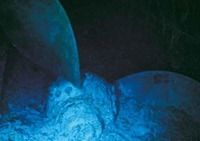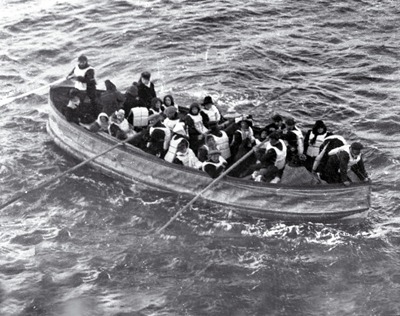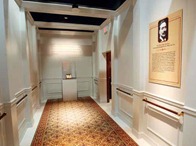Titanic – 100° anniversario dell’affondamento
Nella notte fra il 14 e il 15 aprile nel Venerdì di Pasqua del 1912, si consuma la più grande tragedia marittima
in tempo di pace. Un evento destinato a cambiare per sempre l’immagine della marineria mercantile mondiale.
di/by Tealdo Tealdi – foto/photos Courtesy RMS Titanic, Inc., a subsidiary of Premier Exhibition, Inc.
Twentieth Century Fox Italia Asprey, London
 Difficile trovare chi non si sia commosso davanti all’immagine di Leonardo Di Caprio nei panni di Jack Dawson e di Kate Winslet in quelli di Rose Dewitt Bukater sulla prua del Titanic nell’omonima riproduzione cinematografica, chi non sia stato rapito dalla bellezza della scena, avvolto dalla musica e dalle parole della canzone My heart will go on.
Difficile trovare chi non si sia commosso davanti all’immagine di Leonardo Di Caprio nei panni di Jack Dawson e di Kate Winslet in quelli di Rose Dewitt Bukater sulla prua del Titanic nell’omonima riproduzione cinematografica, chi non sia stato rapito dalla bellezza della scena, avvolto dalla musica e dalle parole della canzone My heart will go on.
Un film, questo, che ha conquistato 11 Oscar su 14 nomination, generando incassi per 1,85 miliardi di dollari. Ora, in occasione del 100° anniversario della partenza, sarà ridistribuito a livello mondiale il 6 aprile 2012 nella nuova versione in 3D.
Il regista David Cameron decise di realizzarlo anche perché l’affondamento del Titanic, avvenuto nella notte tra il 14 e il 15 aprile 1912, è rimasto nell’immaginario collettivo di tutto il mondo come la tragedia navale per eccellenza, con 1523 morti su un totale di 2213 imbarcati.
 Indubbiamente è stata quella ad aver pagato il contributo più alto di vite umane, ad aver rotto il credo delle navi inaffondabili, colpito per la serie incredibile di circostanze negative, preconizzando la fine di un’epoca, di un modo di vivere che, prima la Guerra Mondiale e poi la grande depressione economica, avrebbero definitivamente spazzato via.
Indubbiamente è stata quella ad aver pagato il contributo più alto di vite umane, ad aver rotto il credo delle navi inaffondabili, colpito per la serie incredibile di circostanze negative, preconizzando la fine di un’epoca, di un modo di vivere che, prima la Guerra Mondiale e poi la grande depressione economica, avrebbero definitivamente spazzato via.
Il trasporto marittimo, soprattutto quello passeggero, era aumentato a dismisura, con nove milioni di persone che avevano attraversato l’Atlantico nei precedenti 50 anni.
Le navi si erano molto evolute in quegli anni, aumentando considerevolmente sia la capacità di carico sia la velocità ma, a fronte di una diminuzione del flusso degli emigranti per la politica di restrizione delle autorità americane, gli armatori pensarono di attirare clienti con la passione per i viaggi, pronti a pagare cifre più alte, anche se la maggior parte degli incassi continuava a giungere da chi aspirava ad espatriare.
Si puntò pertanto ad aumentare quella che oggi verrebbe chiamata customer satisfaction, servendo cibo fresco e riuscendo così a rivaleggiare con i servizi offerti nei grandi alberghi della terraferma.


Il Titanic a Southampton, dove si era fermato per fare rifornimento, prima della traversata atlantica. Il capitano Edward John Smith era al suo ultimo comando prima del pensionamento.
I costi sul Titanic erano abbastanza alti: quello per una cabina doppia di terza classe era di circa 40 dollari, corrispondente al salario di due mesi di un operaio, mentre in seconda classe si avevano a disposizione spazi comuni pari a quelli di prima classe della maggior parte dei piroscafi dell’epoca, con prezzi che salivano a 125 dollari. Gli amanti del lusso arrivavano a spendere da 2.500 a 4.000 dollari per le due suites presidenziali.


Foto delle eliche prima del varo e come, a più di 3800 metri di profondità.

Decine di disegnatori al lavoro nella “Drawing Office” degli ingegneri del cantiere Harland & Wolff di Belfast.


L’affilata prua. La sala caldaie, dove una moltitudine di fuochisti lavoravano in condizioni quasi estreme.
Non si deve pensare, comunque, che attraversare l’Atlantico fosse semplice: gli incidenti erano all’ordine del giorno, con decine di naufragi ogni anno, per la mancanza di strumentazione radar e l’insidia di un percorso con iceberg e nebbia fitta. Certo è che quando il marinaio Frederick Fleet alle 23,40 di quella terribile notte urlò dal suo posto di osservazione: “Iceberg, right ahead!” niente e nessuno avrebbe potuto evitare quello che sarebbe successo di lì a poco.
Furono proprio quei 37 secondi prima dell’urto a cambiare il corso della storia, come ha scritto Gérard Jaeger nell’ultimo libro fra i 6.000 dedicati a questa immane tragedia, Il était une fois le Titanic.

L’Heart of the Ocean portato da Rose Dewitt Bukater era stato creato per il film da Aspreys & Garrard, usando uno zircone blu di un valore di 10.000 dollari. Asprey ne ha preparato successivamente anche uno vero, usando uno zaffiro di Ceylon di 170 carati, con 65 diamanti del valore di 3,5 milioni di dollari. Venduto in beneficenza per 2,2 milioni di dollari, fu indossato da Céline Dion durante la premiazione degli Oscar del 1998. La tragedia ha ispirato 16 film, il primo già nel maggio del 1912, interpretato dall’attrice americana Dorothy Gibson, sopravvissuta all’affondamento. L’ultimo sarà l’edizione in 3D del film Titanic di Cameron, proiettato nella ricorrenza del 100° anniversario.
Ripercorrere ora, dopo migliaia di libri e articoli, le vicende che hanno portato all’affondamento non potrebbe aggiungere niente a ciò che è già stato detto. Tuttavia, per ricordare il 100° anniversario della tragedia e per immergersi come non mai in quella che era la vita sul famoso transatlantico, basta una visita a una delle numerose esposizioni organizzate dalla RMS Titanic, già apprezzate da oltre 25 milioni d i persone (ulteriori informazioni si trovano sul sito www.rmstitanic.net).


Gli interni della nave avevano uno straordinario livello di qualità, molto raro all’epoca. In basso a destra, una cabina di terza classe.
In Gran Bretagna la ricorrenza è particolarmente celebrata: ricordiamo la “Titanic remembered” al Royal Museum di Greenwich, una fantastica raccolta di oggetti, lettere e fotografie legati alla nave, donata da Walter Lord, la quale sarà esposta dall’8 marzo al 30 settembre.
Lord, autore del bestseller A night to remember, ha intensamente collaborato con James Cameron per il suo film, in quanto considerato uno dei più riconosciuti esperti in materia. Inoltre, al Southampton Sea City Museum nel mese di aprile verrà inaugurata una mostra intitolata “Titanic, the Legend”, poiché ben 549 abitanti della città, molti dei quali erano membri dell’equipaggio, perirono nella tragedia.


La notizia dell’affondamento ebbe risonanza a livello mondiale, anche perché a bordo vi erano tra i più ricchi uomini al mondo. Le vittime italiane, per la maggior parte camerieri, furono 34, mentre i superstiti solo tre.
Dorothy Gibson, Madeleine Astor, moglie di Lord Astor, si salvò, mentre suo marito Lord John Jacob Astor, perì nel naufragio.




Benjamin Guggenheim, Isidor e Ida Straus. Andrews Thomas, ingegnere capo del cantiere Harland & Wolff, considerato come il padre della nave. Joseph Bruce Ismay, direttore della compagnia White Star.

Una scialuppa di salvataggio si avvicina al Carpathia.
Per quanto riguarda le iniziative statunitensi, ricordiamo che a New York l’11 aprile si terrà un’asta di più di 5500 oggetti recuperati dal relitto del transatlantico, in un lasso di tempo di 18 anni, a oltre 3840 metri di profondità. Fu infatti una spedizione guidata da Robert Ballard, dell’Istituto oceanografico di Woods Hole, Boston, a scoprirlo nel 1985, a 650 km a Sud di Terranova (Canada).


5000 oggetti recuperati dagli abissi e appartenuti al Titanic saranno messi in asta, in un unico blocco, a New York il 14 Aprile. Il muro di ghiaccio ricorda l’iceberg che causò l’affondamento.

Foto scattate in profondità, tra cui la prua; un grosso pezzo dello scafo, denominato “The big piece” risale, scortato da un sommozzatore.

Sopra: uno dei batiscafi usati durante le ricerche dalla spedizione di Robert Ballard.
English:
It is difficult to find somebody who was not moved by the image of Leonardo Di Caprio as Jack Dawson and Kate Winslet as Rose Dewitt Bukater on the bow of the Titanic in the film of the same name and who was not enchanted by the beauty of the scene, enraptured by the music and the words of the song My heart will go on.
This film won 11 Oscars out of the 13 it was nominated for, generating takings for $ 1.85 billion. Now, on the 100th anniversary of the departure, it will have a global re-release on April 6, 2012 in the new 3D version. The director David Cameron also decided to make it because the sinking of the Titanic, in the night on April 14 and 15, 1912, has remained in the collection imagination of the whole world as the shipping tragedy par excellence, with 1523 deaths out of a total of 2213 on board.
Unquestionably, it was the one that paid the highest tribute in human lives that broke belief in unsinkable ships, struck by the incredible series of negative circumstances, foretelling the end of an epoch, of a way of life that first World War I and then the Depression were to sweep away for good.
Maritime transport, especially passenger transport, had increased out of all proportion, with nine million people having crossed the Atlantic in the previous 50 years. Ships had greatly developed in those years, considerably increasing both their capacity and speed but, in the face of a reduction in the flow of immigrants due to the restrictive policy of the American authorities, the owners thought of attracting clients with the passion for travel, ready to pay higher fares, even though the majority of income continued to come from those who aspired to emigrate.
Therefore they counted on increasing what today would be called customer satisfaction, serving fresh food and succeeding in rivaling with the services offered in the large hotels on land. The costs on the Titanic were fairly high: For a double cabin in third class, the cost was about $ 40, corresponding to two months’ wages of a laborer, whilst in second class, the passengers had at their disposal common areas like those in the first class of most of the sailing ships of the period, with prices that rose to $ 125.
Lovers of luxury spent up to $ 2,500 and $ 4,000 for the two presidential suites.
Crossing the Atlantic was not easy at all: accidents were normal, with dozens of shipwrecks every year, due to the lack of radar and the danger of the route with icebergs and thick fog. What is certain is that when the seaman Frederick Fleet, at 11-40 p.m. on that terrible night screamed from his point of observation “Iceberg, right ahead!” nothing and nobody could have avoided what was to have happened shortly after that. It was those 37 seconds before the impact that changed the course of history, as Gérard Jaeger wrote in the most recent of the 6,000 books on this huge tragedy, Il était une fois le Titanic [Once upon a time there was the Titanic].
Going back over the events, after thousands of books and articles that led to the sinking could add nothing to what has already been said. However, to commemorate the 100th anniversary o f t he t ragedy and to be immersed as never before in life on board the famous ocean liner, you only have to visit one of the many exhibitions organized by the RMS Titanic, already appreciated by more than 25 million people (further information on the site www.rmstitanic.net).
In Great Britain, the anniversary is particularly celebrated: there is “Titanic remembered” at the Royal Museum of Greenwich, a fantastic collection of objects, letters and photographs linked to the ship, donated by Walter Lord, which will be on display from 8th March to 30th September.
Lord, the author of the bestseller A night to remember, worked intensely with James Cameron on his film, as he is considered one of the greatest experts on the subject. In addition, at the Southampton Sea City Museum, an exhibition entitled “Titanic, the Legend” will be inaugurated in April as 549 inhabitants of the city, many of whom were members of the crew, perished in the tragedy.
As far as the initiatives in the United States are concerned, in New York City on April 11 there will be an auction of more than 550 objects salvaged from the wreck of the liner, over 18 years, at a depth of more than 12,500 feet. It was an expedition led by Robert Ballard, of the Oceanographic Institute of Woods Hole, Boston, who discovered it in 1985, about 400 miles south of Newfoundland (Canada).
Articolo apparso sul N. 70 di Arte Navale – febbraio / maggio 2012 e qui pubblicato p.g.c. dell’autore Tealdo Tealdi
































Lascia un Commento
Vuoi partecipare alla discussione?Sentitevi liberi di contribuire!